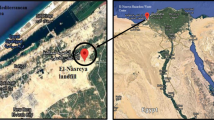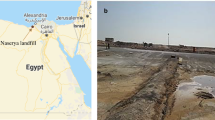Abstract
Clay structures are widely used as impermeable barriers to landfill pollution, although waste can degrade for more than 30 years, no studies concerning the long-term service performance of clay layers under leachate have been reported. In this paper, the in situ clay leaching in landfill for more than 20 years was studied by drilling and sampling. The results show that clay particle contents in soils decreased under long-term leachate effects, causing the liquid limit and plasticity index of the soil to reduce substantially, and the plastic limit to decrease to a lesser extent. The internal friction angle of clay increased, its cohesion decreased, and its compressibility increased, which caused the hydraulic conductivity of clay to increase by 2–4 times at constant porosity following leachate interaction. The long-term effects of leachate led to a reduction in the number of clay minerals, such as montmorillonite, in the soil, the coalescence of soil particles, an increase in the volume of large pores by 132%, a decrease in the volume of small pores by 14.4%, and increased pore connectivity. When landfill waste is undergoing middle and later stages of degradation, the leachate pollutant diffusion depth in the bottom clay layer is approximately 1 m. Since the groundwater is not polluted, our results confirm that the long-term safety aspect of landfill meets the bottom clay impermeability requirements specified in GB16889-2008 (hydraulic conductivity < 10−7 cm/s, thickness > 2 m).









Similar content being viewed by others
Data availability
The authors confirm that the data supporting the findings of this study are included in this article.
References
Aldaeef AA, Rayhani MT (2014) Hydraulic performance of compacted clay liners (CCLs) under combined temperature and leachate exposures. Waste Manage 34(12):2548–2560
Bhatnagar A, Kaczala F, Burlakovs J, Kriipsalu M, Hogland M, Hogland W (2017) Hunting for valuables from landfills and assessing their market opportunities. A case study with Kudjape landfill in Estonia. Waste Management & Research: the Journal for a Sustainable Circular Economy 35:627–635
Bradshaw SL, Benson CH (2014) Effect of municipal solid waste leachate on hydraulic conductivity and exchange complex of geosynthetic clay liners[J]. J Geotech Geoenviron Eng 140(4):04013038.1–04013038.17
Benson CH, Meer SR (2009) Relative abundance of monovalent and divalent cations and the impact of desiccation on geosynthetic clay liners. J Geotech Geoenviron Eng 135(3):349–358
Chen Y, Lan J, Li Y, Zhan L, Ke H (2014) Development and control of leachate mound in MSW landfills. Chin J Rock Mech Eng 33(1):154–163
Du Y-J, Liu S-Y, Shigenori H (2006) Some factors controlling diffusive transport of potassium ion through clayey soils. Journal of Southeast University (english Edition) 22(1):106–111
Du YJ, Fan RD, Liu SY, Reddy KR, Jin F (2015a) Workability, compressibility and hydraulic conductivity of zeolite-amended clayey soil/calcium-bentonite backfills for slurry-trench cutoff walls. Eng Geol 195:258–268
Du YJ, Fan RD, Reddy KR, Liu SY, Yang YL (2015b) Impacts of presence of lead contamination in clayey soil–calcium bentonite cutoff wall backfills. Appl Clay Sci 108:111–122
Francisca FM, Glatstein DA (2010) Long term hydraulic conductivity of compacted soils permeated with landfill leachate. Appl Clay Sci 49(3):187–193
Harun N, Ali ZR, Rahim A, Lihan T, Idris R (2013) Effects of leachate on geotechnical characteristics of sandy clay soil. AIP Conference Proceedings. 1571. American Institute of Physics, pp. 530–536
He J, Wang Y, Li Y, Ruan X-C (2015) Effects of leachate infiltration and desiccation cracks on hydraulic conductivity of compacted clay. Water Sci Eng 8(2):151–157
Jafari NH, Stark TD, Thalhamer T (2018) Spatial and temporal characteristics of elevated temperatures in municipal solid waste landfills. Waste Manage 74:1–2
Johnson RL, Cherry JA, Pankow JF (1989) Diffusive contaminant transport in natural clay: a field example and implications for clay-lined waste disposal sites. Environ Sci Technol 23(3):340–349
Li-wen C, Jing Z, Yong W, Xiu-yan L, Lei H (2009) Experimental research on geotechnical behaviors of compacted clay influenced by metal cation. Procedia Earth and Planetary Science 1(1):1016–1023
Li J-S, Xue Q, Wang P, Liu L (2013) Influence of leachate pollution on mechanical properties of compacted clay: a case study on behaviors and mechanisms. Eng Geol 167:128–133
Liu L, Ma J, Xue Q, Shao J, Chen Y, Zeng G (2018) The in situ aeration in an old landfill in China: multi-wells optimization method and application. Waste Manage 76:614–620
Ma T, Wei C, Chen P, Li W (2019) Chemo-mechanical coupling constitutive model for chalk considering chalk-fluid physicochemical interaction. Geotechnique 69(4):308–319
Mortezaei H, Karimpour Fard M (2017) Variation of the hydraulic conductivity of clayey soils in exposure to organic permeants. Civil Eng J 3(11):1036
Oztoprak S, Pisirici B (2011) Effects of micro structure changes on the macro behaviour of Istanbul (Turkey) clays exposed to landfill leachate. Eng Geol 121(3):110–122
Ozcoban MS et al (2013) Hydraulic conductivity and removal rate of compacted clays permeated with landfill leachate. Desalin Water Treat 51(31–33):6148–6157
Quigley RM, Rowe RK (1986) Leachate migration through clay below a domestic waste landfill, Sarnia, Ontario, Canada: chemical interpretation and modelling philosophies. In: Lorenzen D, Conway RA, Jackson LP, Hamza A, Perket CL, editors. ASTM International, West Conshohocken, PA, pp. 93–103
Safari E, Valizadeh R (2018) Analysis of biological clogging potential in a simulated compacted clay liner subjected to high-strength leachate infiltration. Int J Environ Sci Technol 15(5):1029–1038
Setz MC, Tian K, Benson CH, Bradshaw SL (2017) Effect of ammonium on the hydraulic conductivity of geosynthetic clay liners. Geotext Geomembr 45(6):665–673
Somani M, Datta M, Ramana GV, Sreekrishnan TR (2018) Investigations on fine fraction of aged municipal solid waste recovered through landfill mining: case study of three dumpsites from India. Waste Management & Research: the Journal for a Sustainable Circular Economy 36:744–755
Standard for pollution control on the landfill site of municipal solid waste (2008) GB16889, Standards Press of China, Beijing
Standard for groundwater quality (2017) GB/T 14848. Standards Press of China, Beijing
Standard for geotechnical testing method (2019) GB/T 50123. Standards Press of China, Beijing
Wan Y, Xue Q, Liu L (2014) Study on the permeability evolution law and the micro-mechanism of CCL in a landfill final cover under the dry-wet cycle. Bull Eng Geol Env 73(4):1089–1103
Wang B, Xu J, Chen B, Dong X, Dou T (2019) Hydraulic conductivity of geosynthetic clay liners to inorganic waste leachate[J]. Appl Clay Sci 168:244–248
Whitworth TM, Ghazifard A (2009) Membrane effects in clay-lined inward gradient landfills. Appl Clay Sci 43(2):248–252
Xu S, Lu H, Li J, Liu X, Wang W (2018) Microstructure and triaxial shear testing of compacted clay presented in landfill leachate
Xu S, Lu H, Liu J, Li J (2019) An experimental study on the microstructure and triaxial shear of structured clay in contact with landfill leachate. Bull Eng Geol Env 78(6):4611–4622
Xue Q, Zhang Q, Liu L (2012) Impact of high concentration solutions on hydraulic properties of geosynthetic clay liner materials[J]. Materials 5(11):2326–2341
Xue Q, Wan Y, Chen Y-J, Zhao Y (2014) Experimental research on the evolution laws of soil fabric of compacted clay liner in a landfill final cover under the dry-wet cycle. Bull Eng Geol Environ 73(2):517–529
Yao C, Chen P, Ma T, Xia X, Wei C (2020) Physicochemical effect on shear strength characteristics of clayey soils based on ring-shear experiment. Can Geotech J 57(12):1820–1831
Yoobanpot N, Jamsawang P, Horpibulsuk S (2017) Strength behavior and microstructural characteristics of soft clay stabilized with cement kiln dust and fly ash residue. Appl Clay Sci 141:146–156
Zaki AA, Ahmad MI, El-Rahman KMA (2017) Sorption characteristics of a landfill clay soil as a retardation barrier of some heavy metals. Appl Clay Sci 135:150–167
Zhan TLT, Guan C, Xie HJ, Chen YM (2014) Vertical migration of leachate pollutants in clayey soils beneath an uncontrolled landfill at Huainan, China: a field and theoretical investigation. Sci Total Environ 470–471:290–298
Zhao Y, Xue Q, Huang F-X, Hu X-T, Li J-S (2016) Experimental study on the microstructure and mechanical behaviors of leachate-polluted compacted clay. Environ Earth Sci 75(12)
Zhao YC, Liu JY, Huang RH, Gu GW (2000) Long-term monitoring and prediction for leachate concentrations in Shanghai Refuse Landfill. Water Air Soil Pollut 122(3–4):281–297
Funding
This research was supported by the Special Fund for Basic Research on Scientific Instruments of the National Natural Science Foundation of China (grant numbers 51979267 and U20A20320); the Youth Innovation Promotion Association CAS (grant number 2021327); the National Key Research and Development Program (grant number 2019YFC1804002); and the Wuhan Science and Technology Conversion Special Project (2018060403011348).
Author information
Authors and Affiliations
Contributions
Yong Wan: conceptualization, resources, writing—original draft. Dongdong Guo: data curation, methodology, writing—review and editing. Ruiqi Liu: investigation, methodology. Xinminnan Hui: data curation, methodology. Zhiwei Dong: investigation, conceptualization, writing—review and editing. Lei Liu: supervision, writing—review and editing. Qiang Xue: supervision, resources funding acquisition.
Corresponding author
Ethics declarations
Conflict of interest
The authors declare no competing interests.
Rights and permissions
About this article
Cite this article
Wan, Y., Guo, D., Liu, R. et al. Experimental study of the environmental and geotechnical properties of landfills under long-term leachate effects: macro–microscopic tests on in situ clays. Bull Eng Geol Environ 81, 297 (2022). https://doi.org/10.1007/s10064-022-02782-0
Received:
Accepted:
Published:
DOI: https://doi.org/10.1007/s10064-022-02782-0




